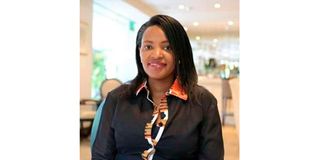Say no to sexual harassment in newsrooms!

Executive Director Association of Media Women in Kenya, Judie Kaberia. She has encouraged women harassed in newsrooms to stand up against the offence.
What you need to know:
- Stakeholders demand that media houses commit to creating safe spaces for journalists to freely work.
- They expressed concern that many journalists’ careers would be destroyed if sexual harassment remained unchallenged.
- Amwik Executive Director, Judie Kaberia encouraged women harassed in the newsrooms to stand up against the offence.
Media stakeholders have called for an end to sexual harassment in the newsrooms.
They demand that the media houses commit to creating safe spaces for journalists to freely work.
“We need a framework where media entities are committed to providing a sexual harassment-free environment,” said Journalists for Human Rights (JHR) program manager, Sammy Muraya last Friday.
He spoke during a media stakeholders meeting to review an anti-sexual harassment policy to be adopted by the media houses.
“We believe that developing inclusive gender policies and practices is key to fostering gender-equitable environments within our media outlets,” he said.
Victims
During the forum convened by JHR and Association of Media Women in Kenya (Amwik), the stakeholders were concerned that many journalists’ careers would be destroyed if sexual harassment remained unchallenged.
“It’s sad that it’s the victims that are always asked to leave and not the perpetrators. So yes, it’s time to say no!” Mr Muraya emphasised.
Amwik Executive Director, Judie Kaberia encouraged women harassed in the newsrooms to stand up against the offence.
“We are not encouraging women to leave the media spaces but we want them to speak out. It is the perpetrator who should suffer,” she said.
A 2020 Reporting Newsroom Sexual Harassment in Kenya, Nigeria and South Africa study by City, University of London researchers in which Amwik participated, found that on average, women experienced sexual harassment four times more than men.
Of the 202 news professionals interviewed, 20 per cent reported to have experienced sexual harassment at least five times at work. This was similar case for the 8.1 per cent of men surveyed.
Diversity policy
Of worry is lack of deliberate action to eliminate the vice from the newsrooms
In a 2020 The Gender Agenda: Assessing the Gender Issues in the Kenyan Media study by Media Council of Kenya,72 per cent of the 71 journalists interviewed indicated that most media organisations don’t have gender or diversity policy - thus even discussion on addressing the vice is impossible.
Overall, the executives are the main perpetrators (41 per cent) of the sexual harassment, followed by colleagues (38 per cent) and news sources (17 per cent), found a recent study by World Association of News Publishers (Wan-Ifra) Women in News.





